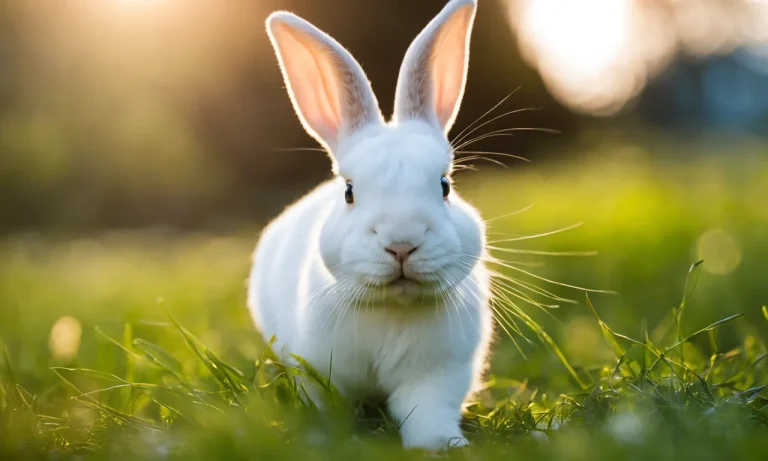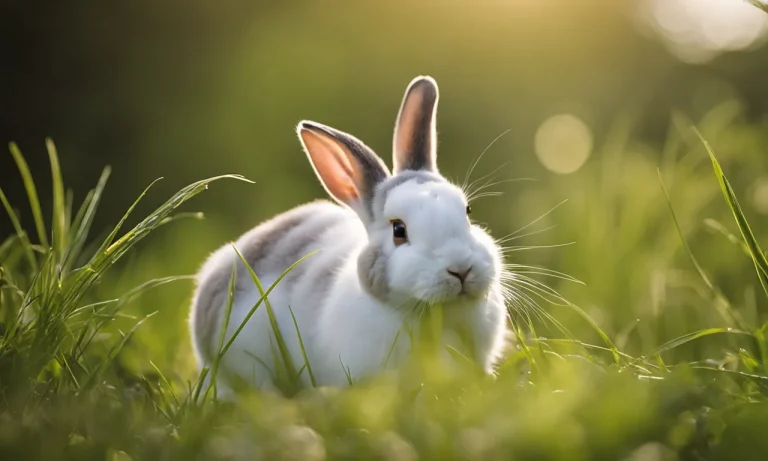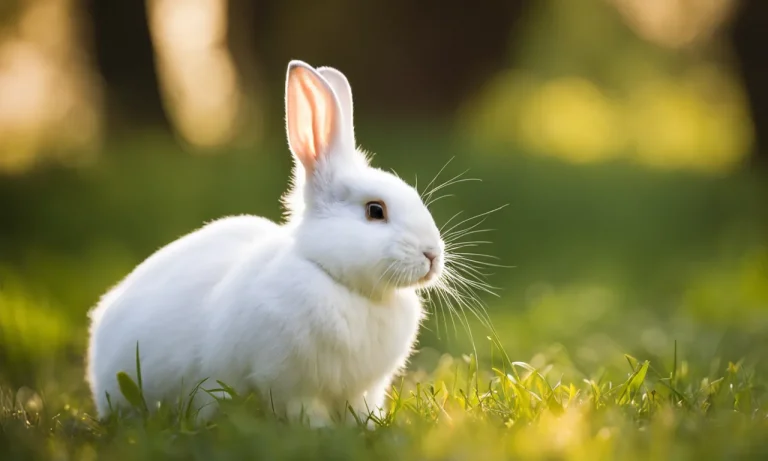Rabbits are a common sight in many backyards, parks, and fields. With their fluffy tails and twitchy noses, they captivate many nature lovers. But beneath that cute exterior lies an important role in nature’s food chain.
Understanding where rabbits fit into the intricate web of who eats whom reveals key insights into ecosystem dynamics.
If you’re short on time, here’s a quick answer to your question: As herbivores that eat grasses, leaves, buds, and bark, rabbits are prey for a variety of predators including hawks, eagles, owls, foxes, coyotes, bobcats, snakes, and humans.
Their abundance makes them a key energy source in many food chains.
In this comprehensive guide, we will unpack the details of the rabbit food chain from start to finish. Read on to learn exactly what rabbits eat, which species prey on rabbits, how rabbits avoid predators, and why rabbits are such an integral part of so many ecosystems.
What Do Rabbits Eat? Understanding the Rabbit Diet
Rabbits are herbivorous grazers, meaning their diet primarily consists of plant material. In the wild, rabbits feed on a variety of vegetation such as grass, weeds, leaves, and bark. They have a unique digestive system that allows them to efficiently process plant matter and extract essential nutrients.
Herbivorous Grazers
Rabbits are known for their ability to graze on vegetation. They spend a significant portion of their day foraging for food, nibbling on grass and plants. This grazing behavior is essential for their survival, as it helps maintain their dental health and provides them with a constant source of nutrients.
Favorite Foods and Foraging Behavior
While rabbits are known to eat a wide variety of plants, they have certain favorite foods that they particularly enjoy. Some of their favorite foods include clover, dandelions, parsley, and carrots. Rabbits are also known to exhibit selective foraging behavior, where they choose certain parts of plants over others.
For example, they may prefer young and tender leaves over older and tougher ones.
Special Digestive System to Process Plant Matter
Rabbits have a specialized digestive system that allows them to effectively process plant matter. They have a large cecum, which is a pouch located at the beginning of their large intestine. The cecum contains beneficial bacteria and enzymes that help break down cellulose, a component found in plant cell walls.
Through a process called fermentation, the cecum converts plant material into a more digestible form.
After fermentation, rabbits produce two types of fecal pellets. The first type, called cecotropes, are soft and nutrient-rich. Rabbits consume these directly from their anus, allowing them to reabsorb essential nutrients.
The second type of pellets are the harder, round droppings that are commonly seen. These are the indigestible parts of the plant that are excreted.
Role as a Primary Consumer
Rabbits play a crucial role as primary consumers in the food chain. They consume large amounts of plant material, which helps control vegetation growth in their habitat. Their grazing also provides food for other animals, such as insects and small mammals, who feed on the plants that rabbits have already partially processed.
It is important to note that the rabbit diet may vary depending on factors such as their environment, availability of food, and whether they are domesticated or wild. For a more detailed understanding of the rabbit diet and nutritional requirements, it is recommended to consult with a veterinarian or reputable sources such as the House Rabbit Society.
Natural Predators of Rabbits in the Wild
Rabbits, like many other animals, have their fair share of natural predators in the wild. These predators play a crucial role in maintaining a balanced ecosystem. Here are some of the most common natural predators of rabbits:
Birds of Prey – Hawks, Eagles, and Owls
Birds of prey such as hawks, eagles, and owls are formidable hunters and pose a significant threat to rabbits. With their keen eyesight and sharp talons, these birds can swoop down on unsuspecting rabbits and snatch them up with ease.
They are particularly skilled at hunting rabbits in open fields and grasslands. Rabbits have developed several defensive tactics to evade these aerial predators, such as running in zigzag patterns and seeking cover in dense vegetation.
Mammalian Predators – Foxes, Coyotes, Bobcats
Mammalian predators, including foxes, coyotes, and bobcats, are also prominent hunters of rabbits. These predators are known for their speed, agility, and excellent sense of smell, making them formidable opponents for rabbits. They often rely on stealth and patience to ambush their prey.
Rabbits have adapted to their presence by digging burrows and creating intricate tunnel systems to escape from these land-based predators. In some cases, rabbits can outrun their pursuers, reaching speeds of up to 45 miles per hour.
Reptilian Predators – Snakes
Snakes, especially species like the rattlesnake and the garter snake, are natural predators of rabbits. These cold-blooded reptiles use their stealth and venom to capture and immobilize their prey. Snakes are particularly adept at hunting rabbits in their burrows.
Rabbits have evolved a heightened sense of hearing and can detect the presence of snakes, enabling them to flee or alert others of the danger.
Humans as Predators
While humans are not considered natural predators of rabbits, they can still pose a threat to their population. Hunting, urbanization, and habitat destruction can negatively impact rabbit populations. However, humans also play a vital role in conservation efforts and can help protect rabbit populations by preserving their natural habitats and implementing sustainable practices.
For more information on rabbits and their natural predators, you can visit https://www.nwf.org/ or https://www.iucnredlist.org/.
Rabbit Anti-Predator Adaptations and Avoidance Behaviors
Keen Senses – Sight, Smell, Hearing
Rabbits have evolved a set of keen senses that help them detect and avoid predators. Their large eyes provide excellent vision, allowing them to spot predators from a distance. Additionally, rabbits have a wide field of view, with their eyes positioned on the sides of their head, giving them nearly 360-degree vision.
This helps them keep an eye out for potential threats from all directions. Along with their sharp eyesight, rabbits have a highly developed sense of smell, which allows them to detect predators even when they are hidden or approaching silently.
Their large ears and acute hearing also play a crucial role in their survival. Rabbits can detect the slightest sounds, including the rustling of leaves or the footsteps of predators, allowing them to react quickly and escape to safety.
Cryptic Coloration and Camouflage
Rabbits possess a remarkable ability to blend into their surroundings through cryptic coloration and camouflage. Their fur color and pattern often match the environment they inhabit, providing them with a natural disguise.
For example, rabbits living in grassy areas may have brown or tan fur, while those in snowy regions may have white fur. This camouflage helps them remain inconspicuous and avoid detection by predators.
By blending into their surroundings, rabbits increase their chances of survival by reducing the likelihood of being spotted and targeted by predators.
Evasive Maneuvers and Escape Burrows
When faced with a predator, rabbits employ a variety of evasive maneuvers to avoid capture. Their powerful hind legs allow them to run at high speeds, reaching up to 45 miles per hour. This incredible speed enables them to outrun many predators, making it difficult for them to be caught.
Additionally, rabbits are skilled at changing direction rapidly, making it challenging for predators to anticipate their movements. In situations where running is not an option, rabbits have another trick up their sleeve – escape burrows.
These burrows are complex tunnel systems that rabbits dig in advance as a means of escape. If a predator gets too close, rabbits can quickly dive into their burrows, where they are safe from harm.
Breeding Rapidly to Sustain Populations
One of the key strategies that rabbits employ to sustain their populations is rapid breeding. Rabbits have a high reproductive rate, with females capable of producing multiple litters each year. A female rabbit can become pregnant again shortly after giving birth, allowing them to produce a new litter every few weeks.
This rapid breeding helps offset any losses due to predation, ensuring the survival and growth of rabbit populations. By reproducing quickly, rabbits are able to maintain their numbers and adapt to changing environments, ensuring their long-term survival.
The Rabbit’s Key Role in the Ecosystem Food Chain
Rabbits play a crucial role in the food chain within the ecosystem. As prey animals, they serve as a vital food source for numerous predators, contributing to the delicate balance of nature.
Prey for Multiple Predators
Rabbits are hunted by a diverse range of predators, including foxes, coyotes, hawks, and owls. Their ability to reproduce quickly helps to sustain predator populations, ensuring a stable ecosystem. Without rabbits as a food source, many predator species would struggle to survive and maintain their own populations.
Population Booms and Busts
Rabbit populations are known for their boom-and-bust cycles, which have a significant impact on the food chain. During boom periods, their numbers increase rapidly, causing an abundance of prey for predators.
However, when resources become scarce or diseases spread, rabbit populations can decline just as quickly. These fluctuations in population size have a cascading effect on the entire ecosystem, affecting the abundance and distribution of predator and prey species.
Impacts on Vegetation
Rabbits are herbivores, and their feeding habits can have both positive and negative effects on vegetation. They consume a variety of plant species, helping to control certain plant populations and prevent overgrowth.
However, in areas with high rabbit densities, their feeding can lead to overgrazing and damage to vegetation. This can have consequences for other herbivores that rely on the same plants for sustenance.
Nutrient Cycling Through Decomposition
Rabbits also contribute to nutrient cycling within the ecosystem through decomposition. When rabbits die, their bodies decompose and release valuable nutrients back into the soil, enriching it for other plants and organisms.
This process helps to maintain the overall health and productivity of the ecosystem.
Threats Facing Rabbit Populations
Habitat Loss and Fragmentation
Habitat loss and fragmentation pose significant threats to rabbit populations. As human populations expand and urbanization continues, natural habitats are being destroyed or converted for agricultural, industrial, and residential purposes.
This loss of habitat leaves rabbits with fewer places to live, breed, and find food, leading to a decline in their numbers.
According to a report by the International Union for Conservation of Nature (IUCN), habitat loss has been identified as the primary threat to more than 70% of the world’s rabbit species.
Additionally, habitat fragmentation, where once contiguous habitats are divided into smaller, isolated patches, further exacerbates the problem. Fragmentation restricts the movement of rabbits, making it harder for them to find suitable mates, access resources, and escape from predators.
To learn more about rabbit habitat loss and fragmentation, visit https://www.iucn.org/.
Invasive Species and Disease
Invasive species and diseases also pose a significant threat to rabbit populations. The introduction of non-native predators and competitors can disrupt the delicate balance of ecosystems and put rabbits at risk.
In some cases, invasive predators such as feral cats and foxes can decimate rabbit populations by preying on them.
Moreover, rabbits are susceptible to various diseases, including myxomatosis and rabbit hemorrhagic disease. These diseases can spread rapidly within rabbit populations, leading to high mortality rates and population declines.
Climate change can also contribute to the spread of diseases by altering the distribution and behavior of disease vectors.
According to a study published in the journal Nature, the introduction of the myxoma virus in Australia resulted in a 90% decline in the rabbit population within a year.For more information on invasive species and diseases affecting rabbits, visit https://www.nature.com/.
Climate Change Impacts
Climate change is another significant threat to rabbit populations. Rising temperatures, changing precipitation patterns, and extreme weather events can directly impact the availability of food and water sources for rabbits.
These changes can disrupt their breeding cycles, alter their distribution, and increase their vulnerability to other threats.
A study published in the journal Global Change Biology found that climate change could lead to a 53% reduction in the suitable habitat for European rabbits by 2050.
Furthermore, climate change can also indirectly affect rabbits by altering the availability and distribution of vegetation, which in turn affects the availability of shelter and food resources.
To explore more about the impacts of climate change on rabbit populations, visit https://www.globalchangebiology.com/.
Overhunting and Poaching
Overhunting and poaching have had devastating effects on rabbit populations, particularly in areas where they are hunted for food or their fur. Unsustainable hunting practices, such as trapping or shooting rabbits without proper regulation, can lead to population declines and even local extinctions.
Poaching, the illegal hunting of rabbits, also poses a significant threat. Rabbits are often targeted for their meat, fur, or as part of illegal wildlife trade. The demand for rabbit products, especially in certain cultures, has contributed to the illegal hunting and trafficking of these animals.
According to a report by the World Wildlife Fund (WWF), unsustainable hunting and poaching have been identified as major contributors to the decline of rabbit populations worldwide.For more information on the impacts of overhunting and poaching on rabbit populations, visit https://www.worldwildlife.org/.
Conclusion
From their diet as herbivores to their key role as prey for diverse predators, rabbits have a complex relationship with the ecosystems they inhabit. Their abundant populations support an array of species even while their foraging behaviors shape vegetation growth.
Yet rabbits also face mounting threats from human activity. Understanding where rabbits fall in the intricate food web provides key insights into how we can protect both rabbit populations and maintainhealthy ecosystems that benefit all species – including our own.







